Are you looking for important questions on Class 10 Science Chapter 7 How do Organisms Reproduce? Look no further! This post provides an exhaustive list of essential MCQs, assertion-reason type questions, and all important questions with their answers that will help you understand the topic better and score maximum in your exams.
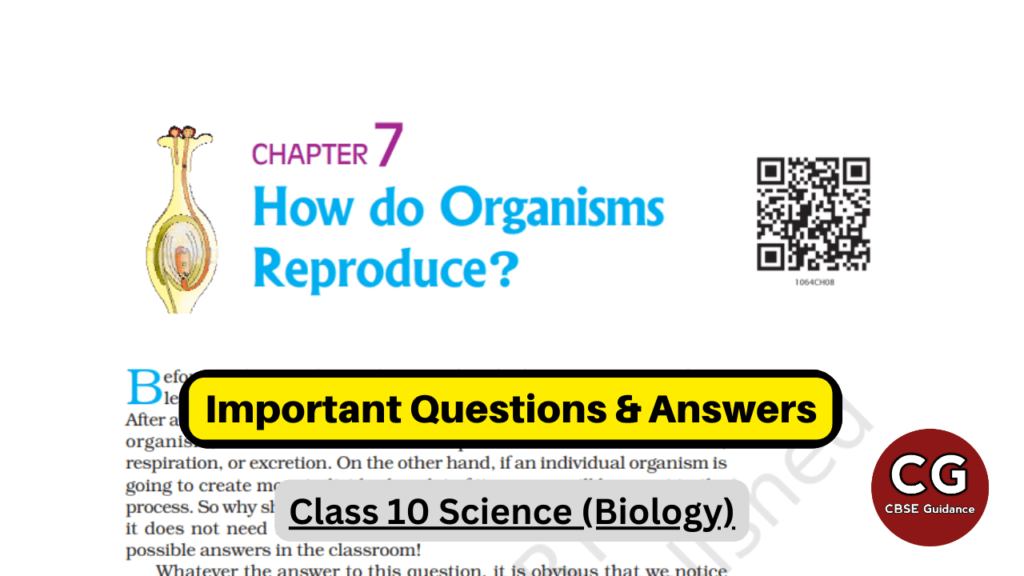
| Subject | Science (Biology) |
| Class | 10 |
| Board | CBSE & State Boards |
| Chapter No. | 7 |
| Chapter Name | How do Organisms Reproduce? |
| Type | Important Questions Answers |
| Session | 2024-25 |
"The only person you should try to be better than is the person you were yesterday."
- Anonymous
How do Organisms Reproduce Class 10 Important Questions and Answers
Q. No. 1) Multiple Choice Questions:
i. The ability of a cell to divide into several cells during reproduction in Plasmodium is called
a. Budding
b. Reduction division
c. Binary fission
d. Multiple fission
Ans. Option (d).
ii. In Spirogyra, asexual reproduction takes place by
a. Breaking up of filaments into smaller bits
b. Division of a cell into two cells
c. Division of a cell into many cells
d. Formation of young cells from older cells.
Ans. Option (a).
iii. When an organism breaks into a number of parts and each part develops into an individual, it is called
a. Regeneration
b. Budding
c. Binary fission
d. Spore formation
Ans. Option (a).
iv. Which of the following is a unicellular organism that reproduces by budding?
a. Spirogyra
b. Bacteria
c. Hydra
d. Yeast
Ans. Option (c).
v. In Rhizopus, tubular thread-like structures bearing sporangia at their tips are called
a. Filaments
b. Hyphae
c. Rhizoids
d. Roots
Ans. Option (b).
vi. Vegetative propagation refers to the formation of new plants from
a. Stem, roots, and flowers
b. Stem, roots, and leaves
c. Stem, flowers, and fruits
d. Stem, leaves, and flowers
Ans. Option (b).
vii. A farmer wants to grow banana plants genetically similar enough to the plants already available in his field. Which one of the following methods would you suggest for this purpose?
a. Regeneration
b. Budding
c. Vegetative propagation
d. Sexual reproduction
Ans. Option (c)
viii. The time duration from the sowing of seeds to the harvest of crops is critical for agricultural purposes.
Based on the information above, select a reason why farmers prefer vegetative propagation for growing crops.
a. Seedless crops can also be reproduced.
b. Offspring plants are genetically similar to parent plants.
c. Plants that are grown by vegetative propagation bear fruits earlier.
d. Vegetative propagation does not depend on external agents of pollination.
Ans. Option (c)
ix. Offspring formed as a result of sexual reproduction exhibit more variations because
a. Sexual reproduction is a lengthy process
b. Genetic material comes from two parents of the same species
c. Genetic material comes from two parents of different species
d. Genetic material comes from many parents
Ans. Option (b).
x. Assertion (A): Offsprings produced by sexual reproduction show variation.
Reason (R): Each offspring produced by sexual reproduction inherits all the genes from each parent.
Options
a. Both A and R are true and R is the correct explanation of A
b. Both A and R are true and R is not the correct explanation of A
c. A is true but R is false
d. A is false but R is true
Ans. Option (c)
xi. In the below figure parts A, B, and C are sequentially

a. cotyledon, plumule, and radicle
b. plumule, radicle, and cotyledon
c. plumule, cotyledon, and radicle
d. radicle, cotyledon, and plumule
Ans. Option (c).
xii. By which process does the number of chromosomes in both parents and offspring of a particular species remain constant?
a. Chromosomes get doubled after zygote formation
b. Chromosomes get halved after zygote formation
c. Chromosomes get doubled after gamete formation
d. Chromosomes get halved during gamete formation
Ans. Option (d).
xiii. Which among the following statements is true for unisexual flowers?
- They possess both stamen and pistil.
- They possess either stamen or pistil.
- They exhibit cross-pollination.
- Unisexual flowers possessing only stamens cannot produce fruits.
a. (1) and (4)
b. (2), (3), and (4)
c. (3) and (4)
d. (1), (3), and (4)
Ans. Option (b).
xiv. The flowers of the Hibiscus, Mustard are _________.
a. Neuter
b. Unisexual
c. Bisexual
d. All of the above
Ans. Option (c).
xv. In a flower, the parts that produce male and female gametes are _________.
a. Stamen and anther
b. Filament and stigma
c. Anther and ovary
d. Stamen and style
Ans. Option (c).
xvi. Which part of the flower matures to form a seed?
a. Ovary
b. Ovule
c. Sepal
d. Petal
Ans. Option (b).
xvii. How many chromosomes are present in the ovum of a human being?
a. 46
b. 44
c. 22
d. 23
Ans. Option (d).
xviii. Secretion of which gland provides nutrition to the sperms?
a. Seminal vesicles
b. Scrotum
c. Testis
d. None of these
Ans. Option (a).
xix. In human males, the testes lie in the scrotum, because it helps in the
a. Process of mating
b. Formation of sperm
c. Easy transfer of gametes
d. All the above
Ans. Option (b)
xx. Which among the following is not the function of the testes at puberty?
- Formation of germ cells
- Secretion of testosterone
- Development of placenta
- Secretion of estrogen
a. (i) and (ii)
b. (ii) and (iii)
c. (iii) and (iv)
d. (i) and (iv)
Ans. Option (c).
xxi. The correct sequence of organs in the male reproductive system for the transport of sperms is
a. Testis → vas deferens → urethra
b. Testis → ureter → urethra
c. Testis → urethra → ureter
d. Testis → vas deferens → ureter
Ans. Option (a).
xxii.
- Assertion (A): The probability of survival of an organism produced through sexual reproduction is more than that of an organism produced through asexual mode.
- Reason (R): Variations provide advantages to individuals for survival.
a. Both (A) and (R) are true and (R) is the correct explanation of (A).
b. Both (A) and (R) are true and (R) is not the correct explanation of (A).
c. (A) is true but (R) is false.
d. (A) is false but (R) is true.
Ans. Option (a)
xxiii. Assertion (A): Simple reproductive methods cannot work for all multicellular organisms.
Reason (R): Multicellular organisms cannot simply divide cell by cell.
a. Both (A) and (R) are true and (R) is the correct explanation of (A).
b. Both (A) and (R) are true and (R) is not the correct explanation of (A).
c. (A) is true but (R) is false.
d. (A) is false but (R) is true.
Ans. Option (a).
xxiv. Assertion (A): The process of DNA copying does not result in variations.
Reason (R): No biochemical reaction is absolutely reliable.
a. Both (A) and (R) are true and (R) is the correct explanation of (A).
b. Both (A) and (R) are true and (R) is not the correct explanation of (A).
c. (A) is true but (R) is false.
d. (A) is false but (R) is true.
Ans. Option (d).
Q. No. 2) When a cell reproduces, what happens to its DNA?
Ans. Its DNA first doubles up followed by its equal and accurate division between two daughter cells.
Q. No. 3) Match the following:
| Column I | Column II |
| A. Amoeba | p. Budding |
| B. Hydra | q. Regeneration |
| C. Planaria | r. Fission |
| D. Rhizopus | s. Fragmentation |
| E. Spirogyra | t. Spore formation |
Ans. A-r, B-p, C-q, D-t, E-s.
Q. No. 4) Write differences between binary fission and multiple fission in a tabular form as observed in the cells of the organisms.
Ans.
| Feature | Binary Fission | Multiple Fission |
| Number of daughter cells | Two | Many |
| Division process | Parent cell divides into two equal halves | Parent cell divides into multiple daughter cells simultaneously |
| Examples | Many bacteria and protozoa like Amoeba, Paramecium, and Leishmania. | Plasmodium (malarial parasite). |
| Speed of division | Relatively faster | Relatively slower |
| Complexity | Simpler | More complex |
| Diagram | iv. 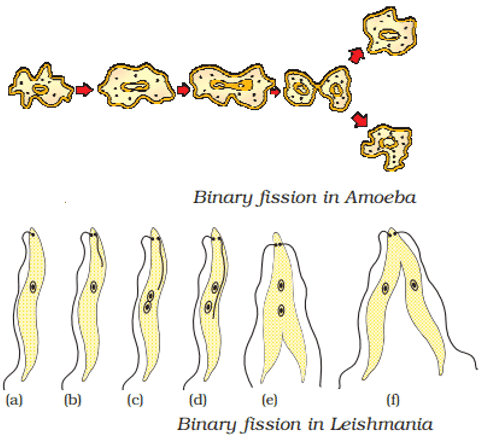 | iv. 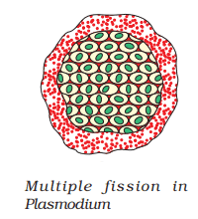 |
Q. No. 5) Why is it not possible to reconstruct the whole organism from a fragment in complex multicellular organisms?
Ans. The reason is that many multi-cellular organisms are not simply a random collection of cells. Specialized cells are organized as tissues and tissues are organized into organs, which then have to be placed at definite positions in the body. Therefore, the cell-by-cell division would be impractical.
Q. No. 6) What is vegetative propagation? List two advantages and two disadvantages of vegetative propagation.
Ans. The method of producing new plants from vegetative parts like roots, stems, and leaves is called vegetative propagation.
The advantages of vegetative propagation are:
- Faster growth and earlier flowering and fruiting.
- Preservation of desired traits.
- Propagation of seedless varieties.
Disadvantages of vegetative propagation are:
- Such plants are genetically similar to parent plants and are vulnerable to infections and diseases.
- They do not have variations, therefore, do not adapt well to changing environments, and the plant species do not evolve.
Q. No. 7) a. Identify the organisms in Figures A, B, C, and D.
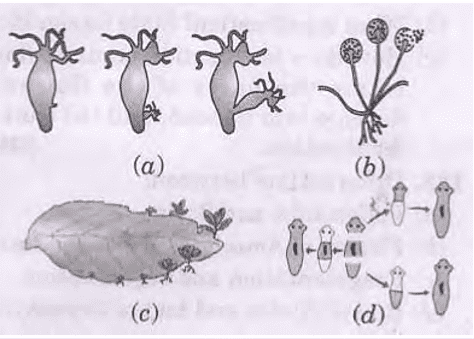
b. Identify the life process commonly shown in all the figures.
c. How is this life process advantageous to the organisms? Mention any two advantages.
Ans. a. A – Hydra
B – Rhizopus
C – Bryophyllum
D – Planaria.
b. Asexual mode of reproduction.
c. Advantages of the asexual mode of reproduction:
- Only one individual is required.
- Progeny is identical to parents.
- Produced in large numbers.
Q. No. 8) Discuss spore formation in fungi. How will an organism benefit if it reproduces through spores?
Ans. Spore Formation: The thread-like structures that develop on bread are the hyphae of the bread mould (Rhizopus). They are non-reproductive parts. The tiny blob-on-a-stick structures are involved in reproduction. The blobs are sporangia, which contain cells, or spores, that can eventually develop into new Rhizopus individuals.
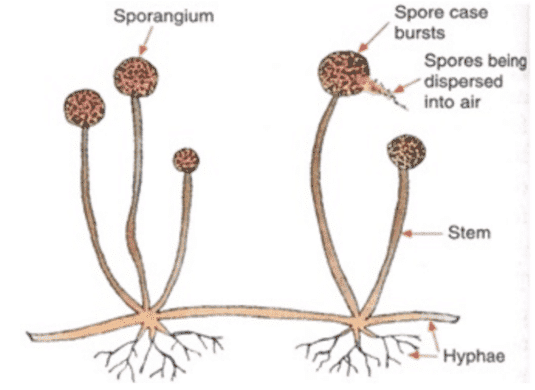
Advantages of spore formation:
- Survival in Harsh Conditions: Spores are highly resistant to extreme conditions like heat, cold, and drought. This helps the organism survive unfavorable environments.
- Wide Dispersal: Spores are lightweight and can easily be carried by wind, water, or animals to distant places. This increases the chances of colonizing new environments.
- Rapid Population Increase: Spores are produced in large numbers, ensuring that even if many are destroyed, some will still survive and grow into new organisms.
Q. No. 9) Reproduction is essentially a phenomenon that is not for the survival of an individual but for the continuation of a species. Justify.
Ans. Variation is important for the survival of a species but can sometimes be harmful to an individual because:
- Adapting to change: Variations make the population diverse, meaning some individuals might have traits that help them survive if the environment changes.
- Helping evolution: Over time, helpful variations can build up in the population, leading to new species that are better suited to their environment.
- Risk to individuals: Although variation helps the species, some changes might not be good for an individual in their specific environment, which could make it harder for them to survive.
Q. No. 10) Write the differences between asexual and sexual types of reproduction. Describe why variations are observed in the offspring formed by sexual reproduction.
Ans.
| Asexual reproduction | Sexual reproduction |
| i. Involves only one parent. | i. It involves two parents. |
| ii. Gametes are not produced. | ii. Gametes are produced. |
| iii. No fertilization and zygote formation. | iii. Fertilization and zygote formation is observed. |
| iv. Produces offspring less rapidly. | iv. Produces offspring more rapidly. |
During sexual reproduction, two types of gametes fuse. Although gametes contain the same number of chromosomes, their DNA is not identical. This situation generates variations among the offspring.
Q. No. 11) Define variation in relation to a species. How are variations useful for species if there is a drastic alteration in the niches?
Or,
Variation in DNA is beneficial for the survival of species over time. Explain.
Ans. Variation means certain changes which occur in sexually reproducing organisms because of errors in DNA copying.
Advantages of variation in DNA:
- Variation allows diversity in organisms.
- In case of drastic alteration of niches, a population with variation is most likely to have some surviving members to ensure the continuity of species.
Q. No. 12) Explain what happens when:
a. Testosterone is released in males.
b. Pollen grain falls on the stigma of the flower.
c. Egg fuses with a sperm cell.
d. Planaria is cut into many pieces.
e. Buds are formed on the notches of the Bryophyllum leaf.
Ans. a.
- Formation of sperms, change in appearance.
- Thick hair growth on the face and the voice begins to crack.
b. A tube grows out of the pollen grain and travels through the style to reach the ovary.
c. Zygote is formed (fertilization).
d. Each piece grows into a complete organism.
e. Buds may fall on the soil and develop into new plants.
Q. No. 13) Draw the diagram of a flower and label the four whorls. Write the names of gamete-producing organs in the flower.
Ans.
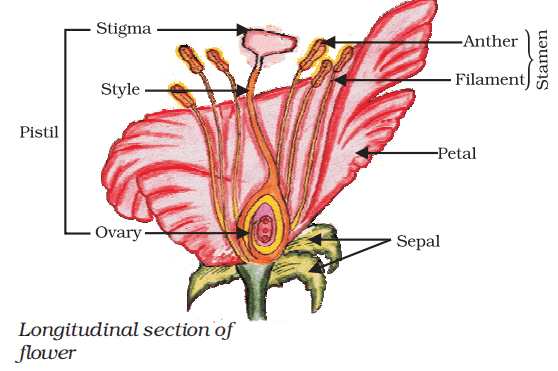
Male gamete forming part – anther/stamen.
Female gamete forming part – pistil/ovary/ovule.
Q. No. 14) Distinguish between pollination and fertilization. Mention the site and product of fertilization in a flower. Draw a neat, labeled diagram of a pistil showing pollen tube growth and its entry into the ovule.
Ans.
| Pollination | Fertilization |
| i. It is the transfer of pollen grain from the anther to the stigma of a flower. | i. It is the fusion of the male gamete with the female gamete. |
| ii. It is achieved by agents like wind, water, or animals. | ii. It is achieved by the growth of the pollen tube so that the male gamete reaches the female germ cells. |
| iii. It leads to fertilization. | iii. It leads to the formation of seeds. |
| iv. It is an external process. | iv. It is an internal process. |
The site of fertilization is the ovule.
The product of fertilization is a zygote.
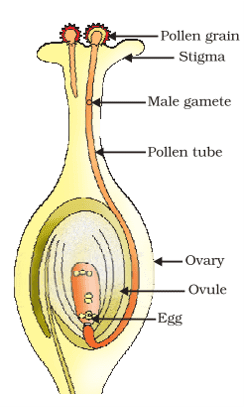
Q. No. 15) Differentiate between self-pollination and cross-pollination.
Ans.
| Self-pollination | Cross-pollination |
| i. It is the transfer of pollen grains from the anther to the stigma within the same flower. | i. It is the transfer of pollen grains from the anther to the stigma in another flower. |
| ii. It occurs either in the same flower or another flower of the same plant. | ii. It occurs between two flowers that are on different plants but are of the same species. |
| iii. It occurs in flowers that are genetically the same. | iii. It occurs between flowers that are genetically different. |
Q. No. 16) Describe the process of seed formation in a flowering plant.
Ans. Process of seed formation in a flowering plant:
- The pollen from the stamen is transferred to the stigma.
- The male germ cell and the female germ cells combine to form the zygote.
- The zygote undergoes rapid division to form the embryo inside the ovule.
- The ovule develops a seed coat and turns into a seed.
Q. No. 17) State the post-fertilization changes that lead to fruit formation in plants.
Ans.
- After fertilization, the zygote divides several times to form an embryo within the ovule.
- The ovule develops a tough coat and is gradually converted into a seed.
- The ovary grows rapidly and ripens to form a fruit.
- The petals, sepals, stamens, style, and stigma may shrivel and fall off.
Q. No. 18) a. Draw a labeled diagram of a human male reproductive system.
b. Give the function of the urethra.
c. Which hormone is released by the testis?
d. Give the function of the prostate gland and seminal vesicle.
Ans. a.
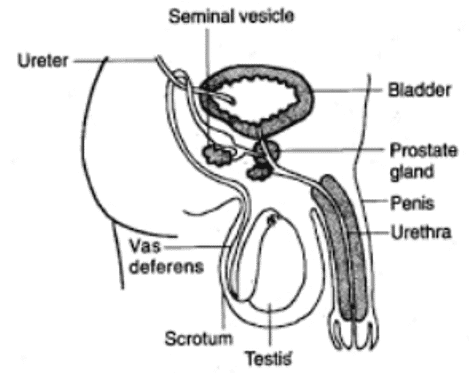
b. The urethra serves as a common passage for both sperm and urine.
c. Testosterone.
d. Prostate gland and the seminal vesicles add their secretions so that the sperms are now in a fluid which makes their transport easier and this fluid also provides nutrition.
Q. No. 19) In the given figure, label the parts and mention their functions:
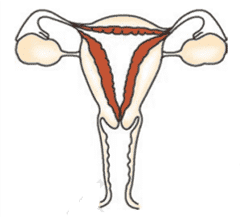
a. Production of egg
b. Site of fertilization
c. Site of implantation
d. Entry of the sperms
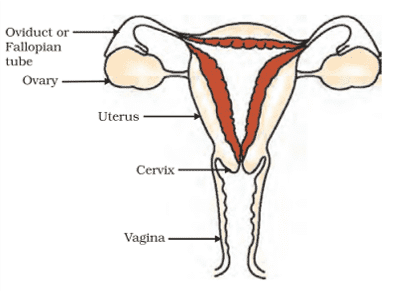
Ans.
a. Ovary (production of egg)
b. Oviduct (site of fertilization)
c. Uterus (site of implantation)
d. Vagina (entry of the sperm)
Q. No. 20) Draw a labeled diagram of a human female reproductive system and explain the function of each organ.
Ans.

Functions of the ovary:
- Production of the female hormone estrogen.
- Production of female gamete.
Functions of Oviduct/Fallopian tube:
- Transfer of female gamete from the ovary.
- Site of fertilization.
Functions of the uterus:
- Implantation of the zygote.
- Nourishment of developing embryo.
Q. No. 21) List four steps in sexual reproduction. Write two of its advantages.
Ans. Four steps in sexual reproduction:
- Formation of gametes in the sex organs.
- Transfer of male gamete to female gamete.
- Fusion of gametes, either inside or outside the female parent's body.
- Development of the zygote to embryo and then complete individual.
Advantages of sexual reproduction:
- Variations are produced among the progeny.
- Such populations are able to adapt well to changing environment and thus evolves faster.
Q. No. 22) Given below are certain situations. Analyze and describe its possible impact on a person:
a) Testes of a male boy are not able to descend into the scrotum during his embryonic development.
b) Vas deferens of a man is plugged.
c) Prostate and seminal vesicles are not functional.
d) Egg is not fertilized in a human female.
e) Placenta does not attach to the uterus optimally.
Ans. a) Sperm formation will be adversely affected because it requires a lower temperature than the body temperature.
b) Vas deferens is a passage for the transfer of sperms, so sperms will not be transferred further.
c) When prostate and seminal vesicles are not functional, they will not add secretions for nourishment and medium for the transport of sperms.
d) When an egg is not fertilized in a human female, it lives for about one day. Then, the thickened lining of the uterus breaks leading to the discharge of blood and mucus along with the unfertilised egg. This is called menstruation.
e) Nutrition and oxygen will not be provided to the growing embryo affecting its growth, which could have serious implications as well.
Q. No. 23) What would be the ratio of chromosome number between an egg and its zygote? How is the sperm genetically different from the egg?
Ans. The ratio is 1:2. Sperms contain either X or Y chromosomes whereas an egg will always have an X chromosome.
Q. No. 24) How are general growth and sexual maturation different from each other?
Ans. General growth refers to different types of developmental processes in the body like an increase in height, weight gain, and changes in shape and size of the body but sexual maturation is specific to changes reflected at puberty like the cracking of voice, new hair patterns, development of breasts in females, etc.
Q. No. 25) Sexual maturation of reproductive tissues and organs are necessary link for reproduction. Elucidate.
Ans. Sexual maturation of reproductive tissues is a necessary link for reproduction because of the need for specialized cells called germ cells to participate in sexual reproduction. The body of the individual organism has to grow to its adult size, the rate of general body growth begins to slow down, and reproductive tissues begin to mature.
A whole new set of changes in the appearance of the body takes place like changes in body proportions, and new features appear. This period during adolescence is called puberty.
There are also changes taking place that are different between boys and girls. In girls, breast size begins to increase, with darkening of the skin of the nipples at the tips of the breasts. Also, girls begin to menstruate at around this time. Boys begin to have new thick hair growth on their faces and their voices begin to crack.
Q. No. 26) What is a placenta? Explain how the uterus and placenta provide necessary conditions for proper growth and development of the embryo after implantation.
Ans. A placenta is a special tissue connection between the embryo and the uterine wall.
Role of the uterus and placenta in the growth and development of the embryo:
- The lining of the uterus thickens and is richly supplied with blood to nourish the growing embryo.
- The embryo gets nutrition from the mother’s blood with the help of the placenta. It is embedded in the uterine wall.
- It contains villi on the embryo’s side of the tissue. On the mother’s side are blood spaces, which surround the villi.
- This provides a large surface area for nutrition and oxygen to pass from the mother to the embryo.
- Waste substances produced by the embryo are removed through the placenta into the mother’s blood.
- The child is born as a result of rhythmic contractions of the muscles in the uterus.
Q. No. 27) What is the sequence of events that take place in human reproduction when an egg is not fertilized?
Ans. When the egg is not fertilized:
- The egg survives for a day in the reproductive system.
- In case the egg is not fertilized, it is shed along with the lining of the uterus out of the vagina as blood and mucus.
Q. No. 28) Suggest any two reasons why child marriages are a hazard to the reproductive health of women.
Ans. Child marriages are a hazard to women's reproductive health because:
- Females will not have reached full sexual maturity at the time of marriage.
- There are possibilities of pregnancy in the teenage years that may cause adverse effects on the female’s body.
Q. No. 29) What are various ways to avoid pregnancy? Elaborate on any one method.
Ans. Contraceptive methods are used such as:
- Mechanical barriers (condoms)
- Drugs (as pills)
- Loop or copper T
- Surgical method.
Pills change the hormonal balance and thus prevent the release of the egg, hence fertilization is prevented. But this method can have some side effects as it interferes with the hormonal balance of the body.
Q. No. 30) Give any three advantages of using a mechanical barrier over other contraceptive measures to avoid pregnancy.
Ans. Advantages of using a mechanical barrier over other contraceptive measures:
- Contraceptive pills can cause hormonal imbalances.
- Copper T and IUD can cause irritation to the uterine lining if not placed correctly.
- Surgical methods, if not performed properly, can lead to infections and complications.
Q. No. 31) Explain an instance where reproduction would be counterproductive to the sustenance of species.
Ans. A higher rate of reproduction would lead to unchecked population growth leading to competition for resources and subsequent lower standards of living.
Download Class 10 Science Chapter 7 How do Organisms Reproduce? NCERT Underlined PDF
| Must Read: How do Organisms Reproduce Class 10 Notes Control and Coordination Class 10 Important Questions with Answers |
| You Might Also Like: CBSE Class 10 Notes CBSE Class 10 Important Questions and Answers |
Hope you liked these Questions Answers on Class 10 Science Chapter 7 How Do Organisms Reproduce? Please share this with your friends and do comment if you have any doubts/suggestions to share.
The answers of these questions are wrong make them correct.
Q1- X, XIII
Q3
Thank you so much for telling me. I have corrected them.
sir question number 30 me advantage ki Jagha per other contraception methode ka disadvantage kyun likhe sir.
Thanks for taking this much effort for us